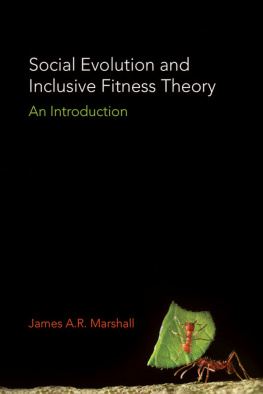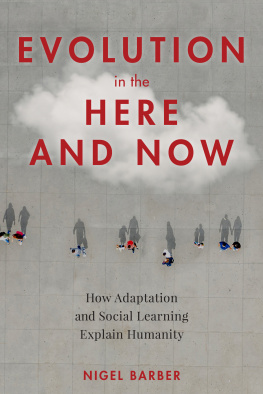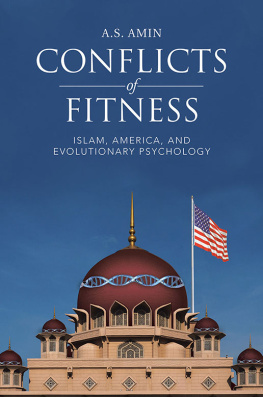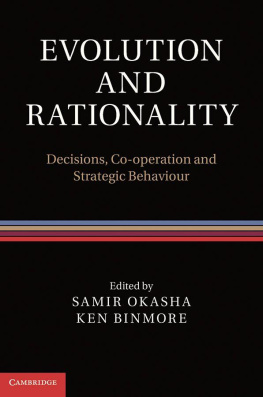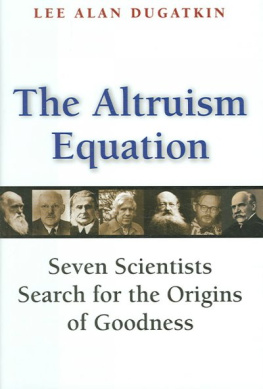
SOCIAL EVOLUTION AND INCLUSIVE FITNESS THEORY
SOCIAL EVOLUTION AND INCLUSIVE FITNESS THEORY
An Introduction
James A. R. Marshall
Princeton University Press
Princeton and Oxford
Copyright 2015 by Princeton University Press
Published by Princeton University Press, 41 William Street, Princeton, New Jersey 08540
In the United Kingdom: Princeton University Press, 6 Oxford Street, Woodstock, Oxfordshire OX20 1TW
press.princeton.edu
All Rights Reserved
Library of Congress Cataloging-in-Publication Data
Marshall, James A. R., 1976
Social evolution and inclusive fitness theory : an introduction / James A.R. Marshall.
pages cm
Includes bibliographical references and index.
ISBN 978-0-691-16156-3 (alk. paper)
1. Sociobiology. 2. Social behavior in animals. 3. Behavior evolution. 4. Evolution (Biology) 5. Social evolution. 6. Hamilton, W. D. (William Donald), 1936-2000. I. Title.
GN365.9.M37 2015
304.5dc23 2014031810
British Library Cataloging-in-Publication Data is available
This book has been composed in Garamond Premr Pro and Avenir LT Std
Printed on acid-free paper.
Typeset by S R Nova Pvt Ltd, Bangalore, India
Printed in the United States of America
10 9 8 7 6 5 4 3 2 1
For Ruth, Hannah, and Adam
LIST OF ILLUSTRATIONS
F IGURES
T ABLES
PREFACE
Inclusive fitness theory is probably the most important advance in our understanding of evolution since 1859. Darwin and Wallaces initial insight, that natural selection could explain adaptation and variation, rested on the assumption that natural selection acts on direct individual reproduction. This assumption remained intact during the mathematical formalization of natural selection theory during the modern synthesis of the 1930s, particularly in the seminal work of R. A. Fisher. Yet if natural selection acts on direct individual reproduction, a fundamental problem arises for the theory: how to explain apparent incidents of self-sacrifice in reproduction by individuals, for the benefit of the reproduction of others? For a while, some researchers assumed the problem could be solved by considering groups as the unit of selection, in which case individuals might sacrifice their own reproduction to benefit that of the group as a whole. However, this nave group selection was shown to be logically inconsistent. The true resolution of the apparent paradox came in 1963 and 1964 with the publication by William D. Hamilton of the theory of inclusive fitness, according to which individuals should value not only their own reproduction, but also that of genetically related individuals. Hamilton thus extended classical DarwinWallaceFisher fitness to a more inclusive version, able to explain the evolution of self-sacrifice.
The goal of this book is to celebrate the 50th anniversary of the publication of Hamiltons inclusive fitness theory by providing a relatively brief introduction to, and explanation of, its generality and its correctness. This is necessary, because both the generality and correctness of inclusive fitness theory have been repeatedly criticized since its inception, and the pace and profile of these criticisms has increased in recent years. The situation for a researcher making their first forays into social evolution theory is daunting. The literature is vast and, given the subtleties of the theory and its apparently controversial status, it can seem difficult to know where to start and what to believe. Large literatures usually require effective summarization in books, and several excellent books in social evolution already exist. Yet all these books achieve something slightly different to the aims of this one. Some are conceptually and technically deep, but may be correspondingly difficult to approach. Others provide a more accessible introduction to the relevant theory, but at the expense of some of the technical depth. Still others survey empirical data on social evolution, and interpret it through the lens of theory. This book aims to fall somewhere between these three extremes, providing a brief primer in the basic concepts of social evolution theory, including its major subtleties and its empirical application, while being simultaneously accessible and technically complete.
What will a reader find in this book, and what will they not? In this book I focus on trying to expose the logical core of inclusive fitness theory, in a way that is understandable to the less mathematically confident, while still providing enough of the technical detail for those who are interested to follow up on. By trying to get to the level of causal explanations of the evolution of social traits, I hope to be able to explain why controversies and misunderstandings have arisen. Explaining how divergent views arise is often a good route towards their speedy resolution. Dealing with causation is, of course, a difficult philosophical problem. The tool I have chosen primarily to base the explanations in this book on is quantitative genetics. Quantitative genetics has been used extensively in studying evolution in general, and many believe it provides a useful route to understanding social evolution. Quantitative genetics is an inherently statistical framework, able to deal with complicated phenotypes, with poorly understood underlying genetics, and still to draw meaningful conclusions. Hence there are no complicated population genetical models in this book. Similarly, popular approaches to developing maximization arguments using concepts of evolutionary stability, which require weak selection, do not feature here. Modeling approaches necessarily trade predictive power against generality, and the focus of this book is on showing the generality of inclusive fitness theory. Because of the minimal assumptions it makes, quantitative genetics has very broad applicability, and the conclusions it draws should hold in great generality. For identifying and explaining the general principles of social evolution theory, it thus seems ideal.
This book was written during the 50th anniversary year of Hamiltons first outline of inclusive fitness theory, and I write these words on the eve of the 50th anniversary year of the first full mathematical presentation of that theory. In the last five decades inclusive fitness has grown from initial obscurity to being generally recognized as the fundamental quantity that natural selection acts on. We should look forward to the even deeper understanding of biological systems that 50 more years of the application of inclusive fitness theory will certainly provide us with.
James A. R. Marshall
Sheffield, December 2013
On the centenary of his death it is particularly fitting to note Wallaces often neglected role in conceiving evolution through natural selection.
ACKNOWLEDGMENTS
Many people have helped to make this book possible, to improve it substantially, or both. First I must thank Tim Clutton-Brock for advice and for putting me in touch with my publisher, Princeton University Press. At the Press I thank the staff, but particularly Alison Kalett for taking a chance on a new and untried author.
In writing this book, and over the years before, I have had useful discussions with a number of people. These include Marco Archetti, Jonathan Birch, Chris Cannings, Tim Clutton-Brock (with particular thanks for a stimulating visit to the Kalihari), Jeff Fletcher, Kevin Foster, Andy Gardner, Bill Hughes, Loeske Kruuk, John McNamara, Samir Okasha, Dave Queller, Corina Tarnita, and Geoff Wild.
Several colleagues were kind enough to provide very useful comments on draft chapters, or parts thereof. These are Marco Archetti, Jonathan Birch, Andrew Bourke, Tim Clutton-Brock, A.W.F. Edwards, Kevin Foster, Steve Frank, Andy Gardner, Melanie Ghoul, Ashleigh Griffin, John McNamara, Samir Okasha, Wenying Shou, and Stu West.
Next page
